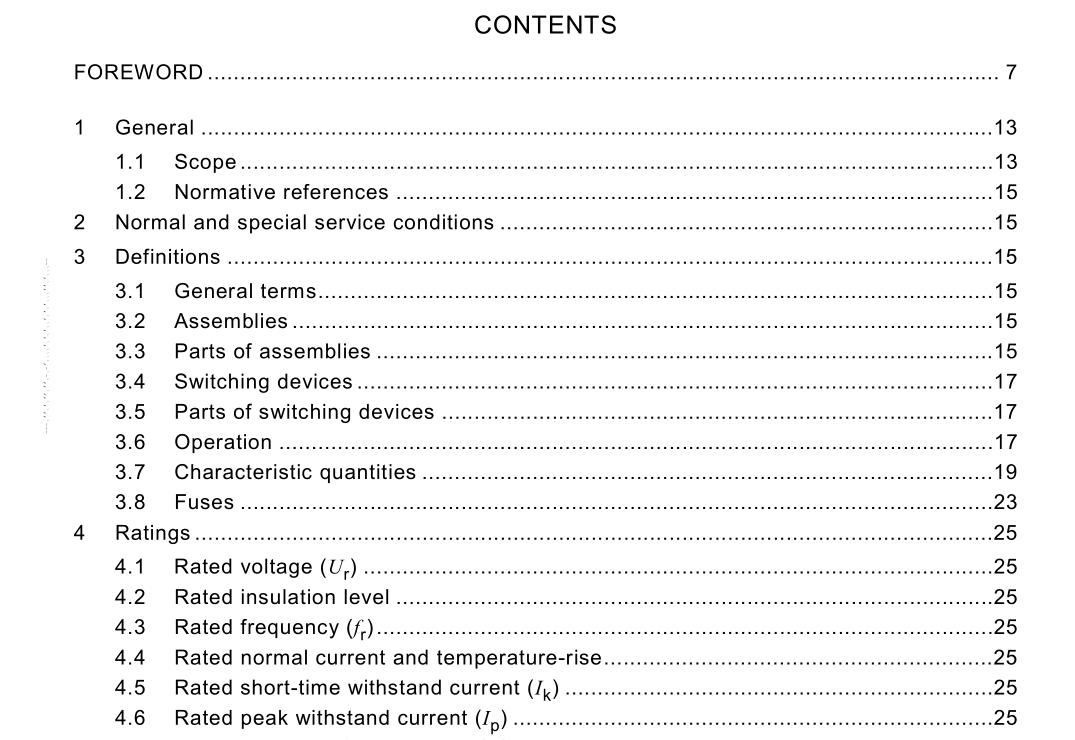IEC 62271-105 pdf download

IEC 62271-105 pdf download.High-voltage switchgear and controlgear
1 General
1.1 Scope This part of IEC 62271 applies to three-pole units for public and industrial distribution systems which are functional assemblies of switches including switch-disconnectors and current- limiting fuses designed so as to be capable of – breaking, at the rated recovery voltage, any current up to and including the rated short- circuit breaking current, – making, at the rated voltage, circuits to which the rated short-circuit breaking current applies. It does not apply to fuse-circuit-breakers, fuse-contactors, combinations for motor-circuits or to combinations incorporating single capacitor bank switches. In this standard, the word “combination” is used for combination in which the components constitute a functional assembly. Each association of a given type of switch and a given type of fuse defines one type of combination. In practice, different types of fuses may be combined with one type of switch, which gives several combinations with different characteristics, in particular concerning the rated currents. Moreover, for maintenance purposes, the user should know the types of fuses that can be associated to a given switch without impairing compliance to the standard, and the corresponding characteristics of the so-made combination. A switch-fuse combination is then defined by its type designation and a list of selected fuses is defined by the manufacturer, the so-called “reference list of fuses”. Compliance with this standard of a given combination means that every combination using one of the selected fuses is proven to be in compliance with this standard.The fuses are incorporated in order to extend the short-circuit breaking rating of the combination beyond that of the switch alone. They are fitted with strikers in order both to open automatically all three poles of the switch on the operation of a fuse and to achieve a correct operation at values of fault current above the minimum melting current but below the minimum breaking current of the fuses. In addition to the fuse strikers, the combination may be fitted with either an over-current release or a shunt release. NOTE In this standard the term “fuse” is used to designate either the fuse or the fuse-link where the general meaning of the text does not result in ambiguity. This standard applies to combinations designed with rated voltages above 1 kV up to and including 52 kV for use on three-phase alternating current systems of either 50 Hz or 60 Hz. Fuses are covered by IEC 60282-1.
3 Definitions
For the purposes of this part of IEC 62271, the definitions of IEC 60050(441) and IEC 60694, as well as the following definitions, apply. Some of them are recalled hereunder for easier use. 3.1 General terms None. 3.2 Assemblies None. 3.3 Parts of assemblies None.3.4 Switching devices 3.4.101 switch-fuse combinations (includes fuse-switch combinations) combination of a three-pole switch with three fuses provided with strikers, the operation of any striker causing all three poles of the switch to open automatically 3.4.102 switch-fuse combinations base (or combination base) switch-fuse combination without fuse-links mounted 3.4.103 switch-fuse [IEV 441-14-14] 3.4.104 fuse-switch [IEV 441-14-17] 3.4.105 switch-disconnector [IEV 441-14-12] 3.4.106 release operated combination combination in which automatic opening of the switch can also be initiated by either an over- current release or a shunt release 3.5 Parts of switching devices 3.5.101 release [IEV 441-15-17] 3.5.102 over-current release [IEV 441-16-33] 3.5.103 shunt release [IEV 441-16-41] 3.6 Operation 3.6.101 independent manual operation (of the switch) [IEV 441-16-16] 3.6.102 stored energy operation (of the switch) [IEV 441-16-15]3.7.109 transfer current (striker operation) value of the three-phase symmetrical current at which the fuses and the switch exchange breaking duties NOTE Above this value the three-phase current is interrupted by the fuse only. Immediately below this value, the current in the first-pole-to-clear is interrupted by the fuse and the current in the other two poles by the switch, or by the fuses, depending on the tolerances of the fuse time current characteristic and the fuse-initiated opening time of the switch. 3.7.110 take-over current [IEV 441-17-16] 3.7.111 minimum take-over current (of a release-operated combination) current determined by the point of intersection of the time-current characteristics of the fuse and the switch corresponding to a) the maximum break time plus, where applicable, the maximum operating time of an external over-current or earth-fault relay, b) the minimum pre-arcing time of the fuse See Figure 12.









